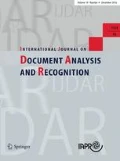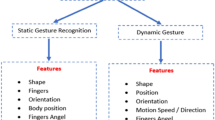Abstract
The task of online handwriting recognition (HR) becomes often challenging due to the presence of confusing characters which are separable by a small region. To address this problem, we propose a “discriminative region (DR) selection” technique which highlights the discriminative region that distinguishes one character from another similar character. The existing DR selection approach for online handwriting often finds spurious DR when the intra-class shape variations become higher than the distinction between DRs of the two characters. The proposed technique which is an improved version of the existing approach can minimize the effect of high intra-class variations and results in robust DR selection. In addition, we propose an online HR system enabling DR-based processing in a single-stage classification framework. The use of hidden Markov model and support vector machine classifiers is explored to develop the HR system. The efficacy of the proposals is shown for character and word recognition tasks and evaluated on three databases: the locally collected Assamese character database, UNIPEN English character database and UNIPEN ICROW-03 word database. The recognition results are promising over the reported works.














Similar content being viewed by others
References
Sueiras, J., Ruiz, V., Sanchez, A., Velez, J.F.: Offline continuous handwriting recognition using sequence to sequence neural networks. Neurocomputing 289, 119–128 (2018)
Chherawala, Y., Roy, P.P., Cheriet, M.: Combination of context-dependent bidirectional long short-term memory classifiers for robust offline handwriting recognition. Pattern Recognit. Lett. 90, 58–64 (2017)
Singh, S., Sharma, A., Chhabra, I.: A dominant points-based feature extraction approach to recognize online handwritten strokes. Int. J. Doc. Anal. Recognit. (IJDAR) 20(1), 37–58 (2017)
Zhang, S., Jin, L., Lin, L.: Discovering similar Chinese characters in online handwriting with deep convolutional neural networks. Int. J. Doc. Anal. Recognit. 19(3), 237–252 (2016)
Tagougui, N., Kherallah, M., Alimi, A.M.: Online Arabic handwriting recognition: a survey. Int. J. Doc. Anal. Recognit. 16(3), 209–226 (2013)
Choudhury, H., Prasanna, S.R.M.: Handwriting recognition using sinusoidal model parameters. Pattern Recognit. Lett. (2018). https://doi.org/10.1016/j.patrec.2018.05.012
Samanta, O., Roy, A., Parui, S.K., Bhattacharya, U.: An HMM framework based on spherical-linear features for online cursive handwriting recognition. Inf. Sci. 441, 133–151 (2018)
Bharath, A., Madhvanath, S.: HMM-based lexicon-driven and lexicon-free word recognition for online handwritten Indic scripts. IEEE Trans. Pattern Anal. Mach. Intell. 34(4), 670–682 (2012)
Keysers, D., Deselaers, T., Rowley, H.A., Wang, L.L., Carbune, V.: Multi-language online handwriting recognition. IEEE Trans. Pattern Anal. Mach. Intell. 39(6), 1180–1194 (2017)
Graves, A., Liwicki, M., Fernandez, S., Bertolami, R., Bunke, H., Schmidhuber, J.: A novel connectionist system for unconstrained handwriting recognition. IEEE Trans. Pattern Anal. Mach. Intell. 31(5), 855–868 (2009)
Vuurpijl, L., Schomaker, L., Erp, M.: Architectures for detecting and solving conflicts: two-stage classification and support vector classifiers. Doc. Anal. Recognit. 5(4), 213–223 (2003)
Bellili, A., Gilloux, M., Gallinari, P.: An MLP-SVM combination architecture for offline handwritten digit recognition. Int. J. Doc. Analy. Recognit. 5(4), 244–252 (2003)
Milgram, J., Sabourin, R., Cheriet, M.: Two-stage classification system combining model-based and discriminative approaches. In: Proceedings of International Conference on Pattern Recognition, Vol. 1, pp. 152–155 (2004)
Prevost, L., Oudot, L., Moises, A., Michel-Sendis, C., Milgram, M.: Hybrid generative/discriminative classifier for unconstrained character recognition. Pattern Recognit. Lett. 26(12), 1840–1848 (2005)
Bhowmik, T., Ghanty, P., Roy, A., Parui, S.: SVM-based hierarchical architectures for handwritten Bangla character recognition. Int. J. Doc. Anal. Recognit. 12(2), 97–108 (2009)
Zanchettin, C., Bezerra, B., Azevedo, W.: A KNN-SVM hybrid model for cursive handwriting recognition. In: Proceedings of International Joint Conference on Neural Networks, pp. 1–8 (2012)
Rahman, A.F.R., Fairhurst, M.C.: Selective partition algorithm for finding regions of maximum pairwise dissimilarity among statistical class models. Pattern Recognit. Lett. 18(7), 605–611 (1997)
Xu, B., Huang, K., Liu, C.L.: Similar handwritten Chinese characters recognition by critical region selection based on average symmetric uncertainty. In: Proceedings of International Conference on Frontiers in Handwriting Recognition, pp. 527–532. IEEE (2010)
Leung, K., Leung, C.H.: Recognition of handwritten Chinese characters by critical region analysis. Pattern Recognit. 43(3), 949–961 (2010)
Sundaram, S., Ramakrishnan, A.G.: Performance enhancement of online handwritten Tamil symbol recognition with reevaluation techniques. Pattern Anal. Appl. 17(3), 587–609 (2013)
Ghosh, S., Bora, P.K., Das, S., Chaudhuri, B.B.: Development of an Assamese OCR using Bangla OCR. In: Proceedings of the Workshop on Document Analysis and Recognition, pp. 68–73. ACM (2012)
Choudhury, H., Mandal, S., Devnath, S., Prasanna, S.R.M., Sundaram, S.: Comparison of Assamese character recognizer using stroke level and character level engines. In: Proceedings of National Conference on Communications, pp. 1–6 (2015)
Guyon, I., Schomaker, L., Plamondon, R., Liberman, M., Janet, S.: UNIPEN project of online data exchange and recognizer benchmarks. In: Proceedings of International Conference on Pattern Recognition, pp. 29–33 (1994)
Ratzlaff, E.H.: Methods, reports and survey for the comparison of diverse isolated character recognition results on the UNIPEN database. In: Proceedings of International Conference on Document Analysis and Recognition, pp. 623–628 (2003)
Schomaker, L.: The UNIPEN-ICROW-03 benchmark set. http://www.ai.rug.nl/~lambert/unipen/ icdar-03-competition/_README. Accessed 04 Aug 2017 (2003)
Liwicki, M., Bunke, H.: HMM-based online recognition of handwritten whiteboard notes. In: Proceedings of International Workshop on Frontiers in Handwriting Recognition, pp. 595–599 (2006)
Jaeger, S., Manke, S., Reichert, J., Waibel, A.: Online handwriting recognition: the NPen++ recognizer. Int. J. Doc. Anal. Recognit. 3(3), 169–180 (2001)
Shashikiran, K., Prasad, K., Kunwar, R., Ramakrishnan, A.: Comparison of HMM and SDTW for Tamil handwritten character recognition. In: Proceedings of International Conference on Signal Processing and Communications, pp. 1–4 (2010)
Srihari, S.N., Cha, S.H., Lee, S.: Establishing handwriting individuality using pattern recognition techniques. In: Proceedings of International Conference on Document Analysis and Recognition, pp. 1195–1204 (2001)
Logan, B., Salomon, A.: A music similarity function based on signal analysis. In: Proceedings of IEEE International Conference on Multimedia and Expo, pp. 745–748 (2001)
Maaten, L.V.D., Hinton, G.: Visualizing data using t-SNE. J. Mach. Learn. Res. 9, 2579–2605 (2008)
Kumara, K., Agrawal, R., Bhattacharyya, C.: A large margin approach for writer independent online handwriting classification. Pattern Recognit. Lett. 29(7), 933–937 (2008)
Jayech, K., Mahjoub, M.A., Amara, N.E.B.: Synchronous multi-stream hidden markov model for offline Arabic handwriting recognition without explicit segmentation. Neurocomputing 214, 958–971 (2016)
Mandal, S., Prasanna, S.R.M., Sundaram, S.: Curvature point based HMM state prediction for online handwritten Assamese strokes recognition. In: Proceedings of National Conference on Communications, pp. 1–6 (2015)
Pradhan, G., Prasanna, S.R.M.: Speaker verification by vowel and nonvowel like segmentation. IEEE Trans. Audio Speech Lang. Process. 21(4), 854–867 (2013)
Bahlmann, C., Burkhardt, H.: The writer independent online handwriting recognition system frog on hand and cluster generative statistical dynamic time warping. IEEE Trans. Pattern Anal. Mach. Intell. 26(3), 299–310 (2004)
Google: Google books N-grams. http://norvig.com/google-books-common-words.txt. Accessed 04 Aug 2017 (2012)
Rabiner, L.: A tutorial on hidden Markov models and selected applications in speech recognition. Proc. IEEE 77(2), 257–286 (1989)
Prum, S., Visani, M., Fischer, A., Ogier, J.M.: A discriminative approach to online handwriting recognition using bi-character models. In: Proceedings of International Conference on Document Analysis and Recognition, pp. 364–368 (2013)
Author information
Authors and Affiliations
Corresponding author
Rights and permissions
About this article
Cite this article
Mandal, S., Prasanna, S.R.M. & Sundaram, S. An improved discriminative region selection methodology for online handwriting recognition. IJDAR 22, 1–14 (2019). https://doi.org/10.1007/s10032-018-0314-1
Received:
Revised:
Accepted:
Published:
Issue Date:
DOI: https://doi.org/10.1007/s10032-018-0314-1




